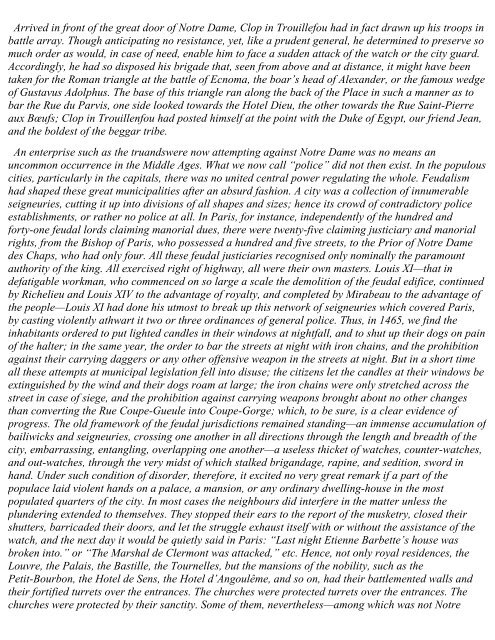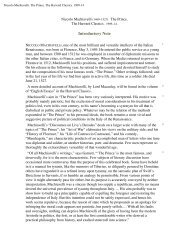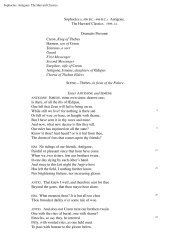Notre Dame de Paris - Bartleby.com
Notre Dame de Paris - Bartleby.com
Notre Dame de Paris - Bartleby.com
Create successful ePaper yourself
Turn your PDF publications into a flip-book with our unique Google optimized e-Paper software.
Arrived in front of the great door of <strong>Notre</strong> <strong>Dame</strong>, Clop in Trouillefou had in fact drawn up his troops in<br />
battle array. Though anticipating no resistance, yet, like a pru<strong>de</strong>nt general, he <strong>de</strong>termined to preserve so<br />
much or<strong>de</strong>r as would, in case of need, enable him to face a sud<strong>de</strong>n attack of the watch or the city guard.<br />
Accordingly, he had so disposed his briga<strong>de</strong> that, seen from above and at distance, it might have been<br />
taken for the Roman triangle at the battle of Ecnoma, the boar’s head of Alexan<strong>de</strong>r, or the famous wedge<br />
of Gustavus Adolphus. The base of this triangle ran along the back of the Place in such a manner as to<br />
bar the Rue du Parvis, one si<strong>de</strong> looked towards the Hotel Dieu, the other towards the Rue Saint-Pierre<br />
aux Bœufs; Clop in Trouillenfou had posted himself at the point with the Duke of Egypt, our friend Jean,<br />
and the bol<strong>de</strong>st of the beggar tribe.<br />
An enterprise such as the truandswere now attempting against <strong>Notre</strong> <strong>Dame</strong> was no means an<br />
un<strong>com</strong>mon occurrence in the Middle Ages. What we now call “police” did not then exist. In the populous<br />
cities, particularly in the capitals, there was no united central power regulating the whole. Feudalism<br />
had shaped these great municipalities after an absurd fashion. A city was a collection of innumerable<br />
seigneuries, cutting it up into divisions of all shapes and sizes; hence its crowd of contradictory police<br />
establishments, or rather no police at all. In <strong>Paris</strong>, for instance, in<strong>de</strong>pen<strong>de</strong>ntly of the hundred and<br />
forty-one feudal lords claiming manorial dues, there were twenty-five claiming justiciary and manorial<br />
rights, from the Bishop of <strong>Paris</strong>, who possessed a hundred and five streets, to the Prior of <strong>Notre</strong> <strong>Dame</strong><br />
<strong>de</strong>s Chaps, who had only four. All these feudal justiciaries recognised only nominally the paramount<br />
authority of the king. All exercised right of highway, all were their own masters. Louis XI—that in<br />
<strong>de</strong>fatigable workman, who <strong>com</strong>menced on so large a scale the <strong>de</strong>molition of the feudal edifice, continued<br />
by Richelieu and Louis XIV to the advantage of royalty, and <strong>com</strong>pleted by Mirabeau to the advantage of<br />
the people—Louis XI had done his utmost to break up this network of seigneuries which covered <strong>Paris</strong>,<br />
by casting violently athwart it two or three ordinances of general police. Thus, in 1465, we find the<br />
inhabitants or<strong>de</strong>red to put lighted candles in their windows at nightfall, and to shut up their dogs on pain<br />
of the halter; in the same year, the or<strong>de</strong>r to bar the streets at night with iron chains, and the prohibition<br />
against their carrying daggers or any other offensive weapon in the streets at night. But in a short time<br />
all these attempts at municipal legislation fell into disuse; the citizens let the candles at their windows be<br />
extinguished by the wind and their dogs roam at large; the iron chains were only stretched across the<br />
street in case of siege, and the prohibition against carrying weapons brought about no other changes<br />
than converting the Rue Coupe-Gueule into Coupe-Gorge; which, to be sure, is a clear evi<strong>de</strong>nce of<br />
progress. The old framework of the feudal jurisdictions remained standing—an immense accumulation of<br />
bailiwicks and seigneuries, crossing one another in all directions through the length and breadth of the<br />
city, embarrassing, entangling, overlapping one another—a useless thicket of watches, counter-watches,<br />
and out-watches, through the very midst of which stalked brigandage, rapine, and sedition, sword in<br />
hand. Un<strong>de</strong>r such condition of disor<strong>de</strong>r, therefore, it excited no very great remark if a part of the<br />
populace laid violent hands on a palace, a mansion, or any ordinary dwelling-house in the most<br />
populated quarters of the city. In most cases the neighbours did interfere in the matter unless the<br />
plun<strong>de</strong>ring exten<strong>de</strong>d to themselves. They stopped their ears to the report of the musketry, closed their<br />
shutters, barrica<strong>de</strong>d their doors, and let the struggle exhaust itself with or without the assistance of the<br />
watch, and the next day it would be quietly said in <strong>Paris</strong>: “Last night Etienne Barbette’s house was<br />
broken into.” or “The Marshal <strong>de</strong> Clermont was attacked,” etc. Hence, not only royal resi<strong>de</strong>nces, the<br />
Louvre, the Palais, the Bastille, the Tournelles, but the mansions of the nobility, such as the<br />
Petit-Bourbon, the Hotel <strong>de</strong> Sens, the Hotel d’Angoulême, and so on, had their battlemented walls and<br />
their fortified turrets over the entrances. The churches were protected turrets over the entrances. The<br />
churches were protected by their sanctity. Some of them, nevertheless—among which was not <strong>Notre</strong>










